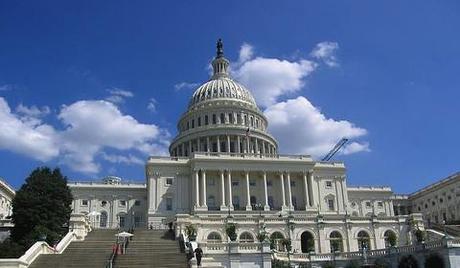
Capitol Hill. Photo credit: Will Palmer
America is only days away from economic Armageddon after negotiations between Democrats, led by President Barack Obama, and Republicans, led by Speaker of the house John Boehner, over raising the US’s debt ceiling broke down once again at the weekend.
America has until August 2 to either raise its Congressionally imposed legal borrowing limit and borrow more money to pay its debts, or be forced to either default or to stop payment on US social benefits, such as Social Security, as well as some government employees’ salaries. The US actually hit its debt ceiling, the borrowing limit placed on the government by Congress, back in May, but in an uncomfortable echo of the last go-round on the budget, the two main political parties have been at an impasse for weeks.
Jonathan Chait of The New Republic explains how Obama finally drew the line and Boehner’s claims that the President walked away are just spin; Keith Hennessy on his blog explains why the opposite was the case.
Both sides are blaming the other for this weekend’s failure: According to President Obama, Boehner “walked away” from an “extraordinarily fair deal”; according to Boehner, Obama “moved the goal posts” during negotiations. The result, however, is that what began as yet another episode of political drama is now materially affecting world markets – jittery markets, starting with Asia, opened lower across the globe amid the cliffhanger negotiations and the turmoil in Europe. Meanwhile, credit ratings agencies have been warning for days that America could be headed for a credit downgrade. At this most delicate time in America’s and the world’s economic recovery, all that spells trouble. Big trouble.
- Where we are now. Both sides are now rushing to put together separate plans that would raise America’s $14.3 trillion debt ceiling, allowing it to avoid a significant suspension of government services and to pay its debts. Democratic Senate Majority Leader Harry Reid has put forth a plan that would raise the debt ceiling by $2.7 trillion, “enough to delay a repeat of this protracted tussle beyond the 2012 elections and assure skittish ratings agencies and investors that the U.S. economy can weather the partisan gridlock in the nation’s capital,” TIME’s Swampland blog explained. The plan would also satisfy two of the Republicans’ key demands: No new taxes and spending cuts to match the debt limit increase, though not from entitlement programmes like Social Security. Boehner, meanwhile, has come up with a two-stage plan that would include “a short-term debt-limit increase accompanied by some $1 trillion or more in spending cuts, followed by the establishment of a commission tasked with finding an additional package of savings in the coming months.” Both, however, would have to sell each other and their respective parties on the plans, meaning it’ll be a “mad scramble” to avoid financial meltdown: “If there is a glimmer of hope amid the morass, it’s that after months of interminable wrangling, fruitless meetings and endless partisan sniping, lawmakers are now in the position in which they have historically thrived: facing an urgent deadline, driven forward by the threat of dire consequence.”
- America is only deferring its debt crisis. Jeff Randall, writing from a relatively safe vantage point in The Telegraph, warned that the US is already bust, owing to its military costs, its social benefits and entitlement programmes, and the fact that no one, not even Americans, can afford to live like Americans. “If Democrats and Republicans can cobble together a compromise this week – and the markets still give them the benefit of the doubt – their fix will be nothing more than crisis deferral. Capitol Hill is in the business of Micawberism. What price the Fed resorts again to printing money?”
- Welfare state or permanent austerity? “The battle over the debt ceiling is only the latest skirmish in what promises to be an ongoing, exhausting war over budget issues,” acknowledged Arthur C. Brooks, president of the American Enterprise Institute, in an op-ed for The Wall Street Journal. But Brooks warned that America is headed for one of two unfortunate options: The Swedish model, featuring high taxation and high government spending, or the Greek model, when the welfare state collapses under its own weight and ends up in permanent austerity. What is needed is real, long-term reform, the likes of which is not manifest in this current debate. “If reformers want Americans to embrace real change, every policy proposal must be framed in terms of self-realization, meritocratic fairness and the promise of a better future,” he wrote. “History shows that big moral struggles can be won, but only when they are seen as decade-long fights and not just as a way to prevail in the next election.”
More on the US debt ceiling crisis
- Despite claims of ‘progress’, no end in sight to partisan debate
- US risks credit downgrade in debt ceiling stalemate
- Debt talks floundering, partisanship blamed
- The US’s dismal June jobs report: Smells like recession

